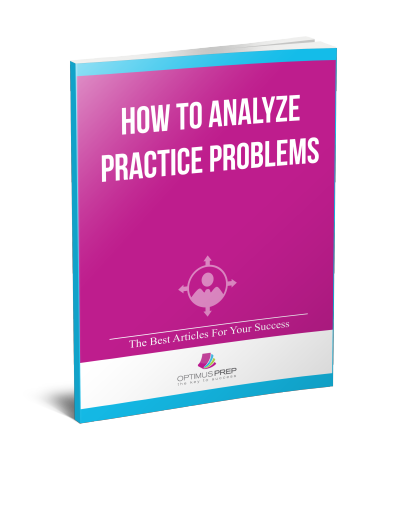
Whenever we review practice problems, our ultimate objective would be to become an expert at the problem we’re focusing on at the moment. So what does mastery really mean? This in essence means that, any time we notice an upcoming different problem that tests the very same thing as this present problem, we are going to notice that the upcoming problem possesses some things in common with this present problem, and we are going to understand what actions to take consequently — we are going to, understand how to proceed on the upcoming different problem, a situation we’ve never really observed before.
It’s essential to attain this standard of mastery since the problems we examine are never the exact problems we’re required to perform on the examination. However will come across similar problems, ones that have things in common with problems we have previously tackled. Once you realize how to proceed, we will be quicker (which is vital on the test), and we will be more efficient – We’ll probably get it correct since we know the procedure actually worked in a problem we saw previously.
The mastery is where the student will be able to recognize and solve a new problem that is different but similar to previous problems. This ability comes from the analysis we did when trying a new problem for the first time. This is the focus of today’s article: How do you analyze completed practice problems?
You of course would need to try the problem first. Try to complete it within the given test time frame. Select an answer to the problem in the given time, if you know the answer or not. Every part of the test has to be practiced, including a strategy on guessing when you don’t know the answer.
You have completed the problem, what’s next? Did you get the correct answer? Surprisingly, getting the right answer is irrelevant when doing the analysis! Since you are eager to check the answer, go ahead and do so now. Just note it will not affect the review process that much.
Next, answer these questions.
- Did I understand WHAT they were trying to test?
- Was I prepared to CATEGORIZE this problem by topic and subtopic? By procedure/approach? If I had to refer to the book, would I know precisely what section to go to? (If I can’t do this, I will need to take a few moments to categorize it now, as I’m analyzing the question.)
- Did I COMPREHEND the signs, wording, questions, statements, and answer options? Will I understand it all now, when I have enough time to think it over? What do I have to do to understand everything here? How will I retain what I just learned for the future?
- Do I actually understand the CONTENT (facts, knowledge) on the test? Consult your books and teachers to clarify any problems you have.
- How well did I HANDLE the topics they were aiming to test?
- Was my APPROACH the best one? Or was there an even better way to solve the problem? (Usually there is a better way) What is that better approach? How will I remember the best approach the next time I encounter a similar problem?
- Did I have the required SKILLS to follow through? Was there an area I need to improve on? Remember to consult your book and teachers to resolve any topics you don’t fully grasp.
- Did I make mistakes that were careless? If so, WHY did I make those mistakes? What habits do I need to develop or break to avoid careless mistakes in the future?
- Would I be more comfortable with OTHER STRATEGIES that worked before? How do I make an educated guess? (Do this even for questions you got correct – it is easier to cultivate an alternative approach and learn how to make educated guesses on problems you got correct. Utilize the lessons learned when confronted with tougher problems of the similar type /category.
- Am I aware of the TRAP & TRICK the writer used in the questions, including the answers I got wrong? (Don’t forget it is usually much easier to discover and avoid the traps on the problems you got correct! Know how to consciously spot them so that you can avoid then when you are confronting tougher problems.)
- How well did I RECOGNIZE the question?
- Did I make a CONNECTION to a prior problem? If so, exactly what problem(s) was it similar to and why? Do I have to start from the beginning? If so, go to next bullet.
- What CONNECTIONS can I make now while analyzing the problem? Is there something I did previously that is similar to this? In what way are they similar? Did that recognition help to solve the new problem in a better, faster way? (You might have to look at a previous problem and compare the two.)
- HOW can I identify problems that are similar in the future? Is there a way I can maximize my retention of the lessons learned from this problem so I can use it for future similar problems?
For you to get the most out of your studies, you need to be performing the above analysis on ALL GMAT problems you tackle. If you did many OG problems but have neglected the above analysis, then you still have some work to do with those questions. Now is a good time to start the analysis. Doing fewer problems shouldn’t matter, this kind of analysis is time consuming. However, this is exactly how you master these kinds of test by doing in-depth, high-quality reviews.
It would be better to students to do 20 in-depth analysis problems than 50 problems without any kind of analysis. You should be spending typically 2 to 5 times as long on the analysis as you do on the actual problem. In other words on a 2 minute problem you should be doing 4 to 10 minutes of analysis!

